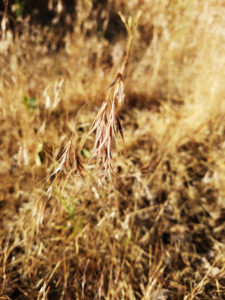Be Careful when Removing the Flammable Weed Cheatgrass
June 29th, 2017
Dried Cheatgrass
When talking with a neighbor, she expressed her concern over the flammability of cheatgrass and asked me how to safely remove it this time of year. As Outreach Coordinator for the Living With Fire Program, this is a common question that I hear from residents during the late spring, early summer time.
In all honesty, the best time to remove cheatgrass is during the early spring before the grass dries and the seeds mature. Unfortunately some individuals haven’t had the opportunity to remove those weeds yet. During this time of the year, a majority of the grass has dried, leaving a straw-like grass that is very flammable.
Let’s review the possible ways to remove cheatgrass: Spraying herbicide this time of year isn’t desirable as the grass is already dead and it won’t do much to the plant. Livestock grazing works well as they will consume it when it’s green, but avoid this method now that it’s dry and the seeds are hard. Pulling cheatgrass is an option, but it’s time consuming especially when there is an abundance of weeds. Mowing or weed whacking the dried grass is a faster method, but that can cause sparks from lawn mower blades or ricocheting rocks starting a fire. I bet you’re asking, “So how do we safely remove cheatgrass?!?”
To help me answer this question, I spoke with North Lake Tahoe Fire Protection District’s Fire Marshal, Mark Regan to discuss the best method to remove cheatgrass this time of year. He recommended mowing or weed whacking in conjunction with the following four suggestions to do so SAFELY:
- Ensure you choose to work on a day that is NOT a Red Flag Warning Day.
Red Flag warning days consider conditions where wildfire could potentially get out of control before first responders can arrive. To see if it’s a Red Flag Warning Day, check out the National Weather Service’s website at http://www.weather.gov/ or follow their social media sites.
- Mow or weed whack during the early morning hours as the humidity is higher.
The cool, early-morning air usually holds more moisture than the dry afternoon or evening air and during dry conditions, it’s easier to ignite a wildfire. Therefore residents should mow or weed whack during the early morning.
- Hose down the work area before and after.
To reduce the possibility of igniting a wildfire, water the work area and surrounding areas before and after mowing or weed whacking. Keep a hose and hand tool handy for quick access and if a fire starts, call 911 immediately. Be sure to monitor the area for at least two hours after mowing or weed whacking.
- Bag-up the cut grass and remove from the site.
Don’t forget to remove the cut weeds from the site.
There you have it! Be sure to follow these recommendations to more safely remove cheatgrass.

Jamie Roice-Gomes
Jamie Roice-Gomes is the outreach coordinator with University of Nevada Cooperative Extension’s Living with Fire Program. She earned her Bachelor of Science in Wildlife Ecology and Conservation and a Master of Arts in Interactive Environmental Journalism. She was a public relations assistant for Conrad Communications, a public information officer intern at the Nevada Department of Conservation & Natural Resources, and a Biological Science Technician at the USDA-Agriculture Research Service. She also enjoys volleyball, the Great Basin Desert, and spending time with family. Contact Jamie at 775-336-0261 or roicej@unce.unr.edu.
